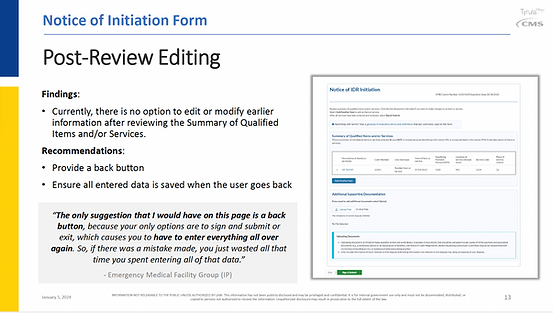User-Centered Design Enabler for Healthcare.gov
Overview of the project
The UCD initiative for healthcare.gov aimed to improve user experience and streamline the design process for one of the most critical government platforms. By developing a cohesive design framework, this project unified eight product design scrum teams across different contracts, minimizing misalignment and reducing redundant work. The project also introduced a data-driven approach to address recurring user issues and implemented a UI/UX inspection strategy that allowed for the proactive resolution of usability challenges within CMS platforms. These combined efforts not only enhanced platform usability but also significantly decreased help desk tickets by 60%.
My role in the project
As the lead design enabler, I spearheaded the creation and implementation of the UCD framework, aligning teams and eliminating duplication of effort. My responsibilities included integrating a data-driven approach to tackle user experience issues directly, which led to a substantial reduction in support requests. Additionally, I developed a UI/UX inspection process with a team of UCD experts that addressed an average of 30% of usability issues upfront, allowing user interviews to focus on more complex needs. This strategic approach facilitated a more efficient design process and delivered a seamless, user-centered experience.
Methods & Activities
-
User Research
-
UI/UX Design
-
Agile Framework
-
Collaborative Cross-Disciplinary Work
-
Communication and Instruction Design
-
User Acceptance Testing (UAT)
My responsibilities
-
Project Management
-
Creating Framework
-
Document and track changes
-
Fostered cross-disciplinary collaboration among team members.
-
Helped Client to Manage UX Strategy Contract
-
Led UAT test
Project Success Highlights
Unified Framework for 9 Contracts
Developed Framework to Harmonize 9 Contracts and Eliminate Conflicts and sat UI/UX system standards.
UCD Across $388M Project
Led the implementation of a framework integrating UCD methodology into the $388 million Healthcare.gov project.
15% Issue Prevention
Integrated design SMEs into UAT, preventing 15% of UI/UX issues from requiring further research.
60% Fewer Help Desk Tickets
Reduced help desk tickets by 60% through redirection of the research agenda and streamlined pipeline.

Healthcare.gov has been an ongoing project since its 2013 launch. I joined as a user-centered designer to enhance usability and elevate the customer experience.
Defining Design Management Tools:
Mapping the Design Process for Non-Designers
I recommended implementing the Double Diamond framework for this project, reinforcing that frameworks are flexible tools intended to be adapted to meet the unique needs and challenges of each initiative. I directed the team to approach the process with an open mind and proactively contribute any insights or ideas that could optimize our strategy as we progressed.
Defining the stages
Recognizing the need for clear guidance for non-designers, I took the lead in crafting a straightforward, step-by-step explanation of the design process and the expected outcomes. Utilizing the double diamond framework, I ensured the information was easily digestible, empowering the team to reference it whenever necessary.

Design Process Timeline:
I established a timeline that outlines the anticipated duration for each step in the design process. While these are estimates that may vary across different workstreams, this section is designed to provide non-designer managers with a clearer understanding of the minimum time commitment required for each phase, facilitating better planning and resource allocation.


Overview of Design Project Stages and Key Requirements
Recognizing the need for clear guidance for non-designers, I took the lead in crafting a straightforward, step-by-step explanation of the design process and the expected outcomes. Utilizing the double diamond framework, I ensured the information was easily digestible, empowering the team to reference it whenever necessary.

Design Management Tracking Frameworks
I created this timeline to provide a clear overview of upcoming design-related projects, supporting better project management and resource allocation. Although not an official timeline, it serves as a planning tool to help the team anticipate design bandwidth needs and streamline efforts.

I tracked Sprint progress and documented insights here to facilitate quick retrospective sessions, enabling us to identify opportunities for process optimization. This approach ensured that projects in the pipeline were organized by priority and sequence for efficient planning and execution.

Strategic Feedback and Enhancements
Here’s a screenshot of the Confluence page where I set up tools to monitor Sprint progress and document key insights throughout the project. By capturing ideas and recommendations in real-time, I helped the team hold productive retrospectives after each Sprint, pinpointing ways to enhance our work and streamline processes.

I developed artifacts to document strategic gaps between the current process and ideal practices identified throughout the project. This approach allowed me to provide targeted solutions and recommendations for process improvement.

Success Highlights
Designed and integrated user-centered frameworks into B2B2C and B2C digital platforms, aligning 9 cross-functional teams to enhance design operations, customer journeys and optimize service touchpoints, resulting in improved outcomes for 3.5 million annual visitors in a $388M project.
60% Help Desk Call Reduction
A 60% reduction in help desk tickets, savings of approximately 10K work hours, and $184K in annual salary costs resulted from prioritizing research inputs and developing service blueprints and customer journey maps.
At Least 60 Hours Saved/Sprint
Integrating design experts into UAT surfaced 15% of UI/UX issues earlier, saving 60 hours per sprint across nine teams by streamlining workflows.
This is an example of overlapping UI/UX issues identified after integrating a design expert into the UAT process. We compared their feedback with findings from prior UX research interviews within the same workstream and discovered that at least 15% of the recommendations were identical. Given that UAT was both faster and more cost-effective, we advised the client to continue including UX researchers as part of the UAT team to streamline issue detection and improve design quality.
.png)